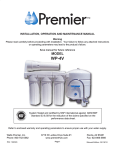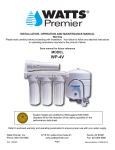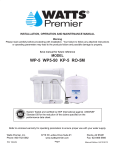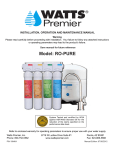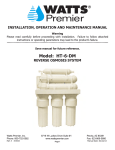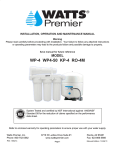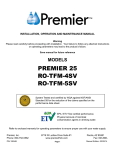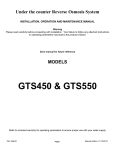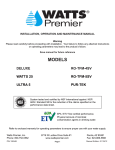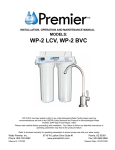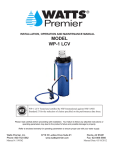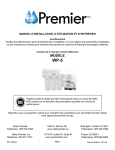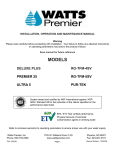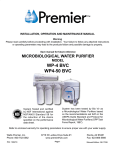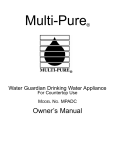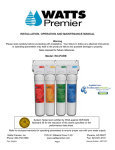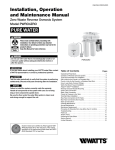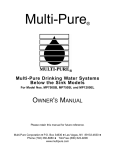Download Watts Premier HT-5-VOC-B Troubleshooting guide
Transcript
INSTALLATION, OPERATION AND MAINTENANCE MANUAL Warning Please read carefully before proceeding with installation. Failure to follow attached instructions or operating parameters may lead to the product’s failure. ****************************************************************************************** Save manual for future reference. Model: HT-5-VOC-B REVERSE OSMOSIS SYSTEM Watts Premier, Inc. Phone: 800-752-5582 Part # 191931 8716 W Ludlow Drive Suite #1 www.wattspremier.com Page 1 Peoria, AZ 85381 Fax: 623-866-5666 Manual Date: 08/31/12 Thank you for your purchase of a state of the art Reverse Osmosis (RO) water treatment system. Water quality concerns are becoming more of a focus for the public. You may have heard about contaminants in the drinking water, such as Arsenic, Chromium, Cryptosporidium or Giardia. There may also be some local water issues such as high levels of Lead and Copper. This Watts water treatment system has been designed and tested to provide you with high quality drinking water for years to come. The following is a brief overview of the system. Your Reverse Osmosis System: Osmosis is the process of water passing through a semi permeable membrane in order to balance the concentration of contaminants on each side of the membrane. A semi permeable membrane is a barrier that will pass some particles like clean drinking water, but not other particles like arsenic and lead. Reverse osmosis uses a semi permeable membrane; however, by applying pressure across the membrane, it concentrates contaminants (like a strainer) on one side of the membrane, producing crystal clear water on the other. This is why RO systems produce both clean drinking water and waste water that is flushed from the system. This reverse osmosis system also utilizes carbon block filtration technology, and can therefore provide a higher quality drinking water than carbon filtration systems alone. Your system is a four stage RO which is based upon separate treatment segments within the one complete water filtration system. These stages are as follows: Stage 1 – Sediment filter, recommended change 6 months. The first stage of your RO system is a five micron sediment filter that traps sediment and other particulate matter like dirt, silt and rust which affect the taste and appearance of your water. Stage 2 – Carbon filter, recommended change 6 months. The second stage contains a 5 micron carbon block filter. This helps ensure that chlorine, chloramines and other materials that cause bad taste and odor are greatly reduced. Stage 3- Membrane, recommended change 2-5 years. Stage three is the heart of the reverse osmosis system, the RO membrane. This semi permeable membrane will effectively take out TDS & Sodium and a wide range of contaminants such as Percholate, Chromium, Arsenic, Copper, Lead as well as Cysts, such as Giardia and Cryptosporidium. Because the process of extracting this high quality drinking water takes time, your RO water treatment system is equipped with a storage tank. Stage 4- VOC Block, recommend change 12 months. Through the specialty formulated VOC filter, your system is capable of reducing harmful Volatile Organic Chemicals (VOC) like MTBE’s, Atrazine, Benzene, 2,4-D,Lindane and others from your drinking water. It is estimated that VOC’s are present in one-fifth of the nation’s water supplies. These water contaminants can enter ground water from a variety of sources including localized use of herbicides and pesticides, gasoline or oil spills, leaking underground fuel tanks, septic system cleaners, and chemicals used in the dry-cleaning industry. Stage 5- Carbon in-line filter, recommended change 6 - 12 months. The final stage is an in-line granular activated carbon (GAC) filter. This filter is used after the water storage tank, and is used as a final polishing filter. Note: Filter & Membrane life may vary based upon local water conditions and/or use patterns. System Maintenance Just because you can not taste it, does not mean that it is not there. Contaminants such as Lead, Chromium and Arsenic are undetectable to the taste. Additionally, over time if you do not replace the filter elements, other bad tastes and odors will be apparent in your drinking water. With proper installation and maintenance, this system will provide you with high quality water for years to come. All of Premier’s water enhancement products are rigorously tested by independent laboratories for safety and reliability. If you have any questions or concerns, please contact our customer service department at 1-800-752-5582 (outside USA 480-675-7995) or refer to our on-line troubleshooting guide at www.wattspremier.com. Page 2 ** Before installation, please take a moment to fill out the warranty card on page 17. Table of Contents Operational Parameters.................................................................................................................... 4 Contents of Reverse Osmosis System............................................................................................. 4 Installation & Startup Tools Recommended For Installation............................................................................................... 4 Plumbing diagram and parts list....................................................................................................... 5 Drill a Hole for the Reverse Osmosis Faucet................................................................................... 6 Mount the Reverse Osmosis Faucet................................................................................................ 6 Blue Tube Connection - To RO Faucet............................................................................................. 6 Adapt-a-Valve Installation ................................................................................................................ 7 How to use Quick Connect Fittings on Your RO System ................................................................. 7 Drain Saddle Installation.................................................................................................................. 8 Drain Saddle Tube Connection........................................................................................................ 8 Green Tube Connection................................................................................................................... 9 Red Tube Connection....................................................................................................................... 9 Tank Ball Valve Installation............................................................................................................... 9 Yellow Tube Connection................................................................................................................... 9 Blue Tube Connection...................................................................................................................... 9 Reverse Osmosis Module Mounting................................................................................................ 9 Start up Instructions....................................................................................................................... 10 Maintenance & Troubleshooting Six Month System Maintenance......................................................................................................11 Annual Maintenance........................................................................................................................11 Membrane Replacement ............................................................................................................... 13 Check Air Pressure in the Tank...................................................................................................... 14 Procedure for Extended Non-Use (More than 2 months)............................................................... 14 Product Technical & Warranty Information Performance Data Sheet................................................................................................................. 15 VOC Performance Data Sheet........................................................................................................ 16 Warranty Registration.................................................................................................................. 17-18 Service Record................................................................................................................................ 19 Limited Warranty............................................................................................................................. 20 Page 3 Operational Parameters Do not use with water that is micro biologically unsafe or of unknown quality without adequate disinfection before or after the system. System is intended to be installed on the cold water line only. Operating Temperatures: Operating Pressure: pH Parameters: Iron: TDS (Total Dissolved Solids) Turbidity Maximum 100°F (37.8°C) Maximum 85 psi (6.0 kg/cm2) Maximum 11 Maximum 0.2 ppm < 1800 ppm < 5 NTU Minimum 40°F (4.4°C) Minimum 40 psi (2.80 kg/cm2) Minimum 2 Hardness: Recommended hardness not to exceed 10 grains per gallon, or 170ppm. System will operate with hardness over 10 grains but the membrane life may be shortened. Addition of a water softener may lengthen the membrane life. Water Pressure: The operating water pressure in your home should be tested over a 24 hour period to attain the maximum pressure. If the incoming water pressure is above 85 psi a pressure regulator is recommended and if over 100 psi then a pressure regulator is required. Copper Tubing: Reverse Osmosis water should not be run through copper tubing as the purity of the water will leach copper causing an objectional taste in water and pin holes may form in the tubing. Watts supplies speciality filters (part number 107008) that can be used if copper tubing follows the Reverse Osmosis unit. Be sure to follow any state or local regulations during installation. Contents of Reverse Osmosis (RO) System 1 Tank1 Transformer 1 RO Module (complete with filters) 1 Parts Bag 1 Pump - Installed 1 Faucet Bag/Box 1 Manual1 Filter Housing Wrench If any of the items are missing please contact Watts prior to installing. INSTALLATION & STARTUP Tools Recommended For Installation √ 1 1/4" Diamond Tipped Hole Saw bit for faucet opening (Counter Tops/Porcelain & Stainless Sinks) √ 1 1/4” Adjustable Wrench √ Phillips bit for electric drill √ 1/2" Open End Wrench √ Needle Nose Pliers √ 5/8” Open End Wrench √ Adjustable Pliers √ Electric Drill √ Sharp Knife √ 1/8" diamond tip bit, pilot hole √ Phillips Screw Driver √ 1/4” drain saddle hole Page 4 Plumbing Diagram and Parts List 1 2 3 4 5 6 7 8 9 10 11 12 13 14 RO FAUCET 15 16 17 18 19 20 21 22 23 24 25 26 27 28 116118 100004 119019 134039 152018 113013 560080 152012 125063 125089 125041 125031 113101 610047 Faucet Polishing Filter Storage Tank Tank Ball Valve Power Transformer Filter Housing Bowl Adapt-a-Valve Booster Pump Tee Fitting Elbow QC 1/4” 1/4 X 1/4 Conn Elbow Compr. 1/4” Membrane Housing ESOV Valve Wire Harness - Pump Green Tubing 1/4” Blue Tubing 1/4” White Tubing 1/4” System Bracket Drain Saddle 3/8” Yellow Tubing 1/4” Filter Housing Lid ESOV Controller Sediment Filter Carbon Block Filter RO Membrane 24GPD VOC Filter Filter Wrench 152040 140007 140004 140009 137031 164016 140029 113067 149067 104017 101009 110009 101013 164055 TRANSFORMER 1 5 BLACK TUBE STAGE 5 FINAL FILTER BLUE TUBE 2 FLOW 9 YELLOW TUBE 20 DRAIN SADDLE STAGE 3 12 RO MEMBRANE 13 ESOV RED TUBE 11 WHITE TUBE 15 8 GREEN TUBE HOT VALVE ADAPTA VALVE COLD 14 Booster Pump 7 ###### 22 SEDIMENT FILTER 10 22 6STAGE 2 CARBON BLOCK FILTER Page 5 3 22 25 24 6STAGE 1 TANK BALL VALVE 27 6 STAGE 4 VOC CB FILTER STORAGE TANK 4 Drill a Hole for the Reverse Osmosis Faucet Marble Counter-top We recommend contacting a qualified contractor for drilling a hole in a marble counter-top. Counter Top / Porcelain & Stainless Steel Sink Note: Most sinks are pre drilled with 1 ¼” diameter hole that you can use for your RO faucet. (If you are already using it for a sprayer or soap dispenser, see step 1) Porcelain sinks are extremely hard and can crack or chip easily. Use extreme caution when drilling. Watts accepts no responsibility for damage resulting from the installation of faucet. Diamond tip bit recommended. Step 1 Determine desired location for the RO faucet on your sink and place a piece of masking tape over where the hole is to be drilled. Mark the center of the hole on the tape. Step 2 Using a variable speed drill set on the slowest speed, drill a 1/8“ pilot hole through both porcelain and metal casing of sink at the marked center of the desired location. Use lubricating oil or liquid soap to keep the drill bit cool (If drill bit gets hot it may cause the porcelain to crack or chip). Step 3 Using a 1 ¼” diamond tip hole saw, proceed to drill the large hole. Keep drill speed on the slowest speed and use lubricating oil or liquid soap to keep the hole saw cool during cutting. Step 4 After drilling, remove all sharp edges and make sure the surroundings of the sink are cooled before mounting the faucet. Mount the Reverse Osmosis Faucet Step 5 Feed both the red and black tubing through the pre drilled hole in the sink/counter until faucet is seated. Step 6 Under the sink - on to the threaded faucet stem in this order first slide on the split washer, white spacer with the open end UP, the plain washer, the lock washer, and lastly secure with nut. Faucet Monitor Function (Not All Models): To activate - pull battery tab. Blue Light: OK Red Light: Change Filters Soon Blue Tube Connection - To RO Faucet Step 7 Step 8 Locate the blue 1/4” tube in the parts bag. Remove a brass nut, plastic sleeve and plastic insert from the faucet parts bag. To assemble, place the brass nut on the blue tube first, then the sleeve (small tapered end of sleeve must point to the end of tube) and then push the plastic insert all the way into the end of the tube. (See Picture) Push the assembled blue tube into the faucet stem until it stops. Slide brass nut and plastic sleeve down until you can thread nut onto the stem. Use a wrench to securely tighten the brass nut while continuing to push the tube into the stem. Page 6 Adapt-a-Valve Installation Caution: Water supply line to the system must be from the cold water supply line only. Hot water will severely damage your system. Black Collet Verify contents prior to installation: ( 1 ) - Plastic Adapt-a-Valve with black collet ( 1 ) - Brass Adapter no washer ( 1 ) - Brass Adapter with black washer ( 1 ) - White rubber washer *White Washer A 3/8” Configuration Hot (With Brass Fittings) Supply * Insert White Washer WARNING: Step 9 A White Washer Cold Supply 1/2” Configuration (Without Brass Fittings) Do not use Teflon tape with the Adapt-a-Valve. Hot Supply Cold Supply Turn off the cold water supply to the faucet by turning the angle stop valve completely off. Open cold water sink faucet to relieve pressure. Step 10 Choosing the configuration that fits your plumbing, attach the adapt-a-valve as illustrated in the four photos above. TIPS: Make sure that the black collet is installed in to the 1/4” opening on the Adapt-a-valve. Don’t forget to install the white compression washer with the 3/8” configuration. Brass adapter (A) does not need to be tightened with a wrench, only finger tight. How to use the Quick Connect Fittings To make a connection, the tube is simply pushed into the fitting. The unique locking system holds the tube firmly in place without deforming it or restricting flow. Use the steps below in reference to any quick connect tube connections. It is essential that the outside diameter be free of score marks and that burrs and sharp edges be removed before inserting into fitting. Fitting grips before it seals. Ensure tube is pushed into the tube stop. To disconnect, ensure the system is depressurized before removing the tube. Push in the collect squarely against face of fitting. With the collet held in this position, the tube can be removed. The fitting can then be reused. Push the tube into the fitting, to the tube stop. The collet (gripper) has stainless steel teeth which hold the tube firmly in position while the O-ring provides a permanent leak proof seal. Pull on the tube to check that it is secure. It is a good practice to test the system prior to leaving site and /or before use. Page 7 Drain Saddle Installation Drain Saddle fits standard 1 ¼” – 1 ½” drain pipes Caution: If you have a garbage disposal, do not install the drain saddle near it. Installation of the drain saddle must be either above the garbage disposal, or if a second sink drain is available, install it above the cross bar on the second drain. Installation of the drain saddle near a garbage disposal may cause the drain line to plug. If no other installation of drain line is available, Watts Premier offers drain line installation kit (part number 164020) that can be used with garbage disposals. Step 11 Gather the pieces of the drain saddle: 1 Black compression nut 1 Semicircle bracket with opening 2 Screws 1 Foam gasket 2 Nuts for screws 1 Semicircle bracket Step 12 The small square black foam gasket with a circle cut out of the middle must be applied to the inside of the drain saddle. Remove sticky tape backing and stick to the drain saddle as shown. Step 13 The drain saddle must be mounted at least 1 ½” above the nut of the P-trap or cross bar from the garbage disposal to insure proper drainage. Assemble the drain saddle around the drain pipe at the best available location. Using Phillips screw driver tighten screws evenly and securely on both sides of the drain saddle. Keep the plastic compression nut off at this time. Caution: Do not over tighten the screws. It may crack the drain saddle. Drill hole and Connect 3/8” Black Tube from Faucet to the Drain Saddle IMPORTANT: The black 3/8” drain tube must be as SHORT and STRAIGHT as possible to the drain saddle, making a downward slope from faucet to drain saddle to allow for proper drainage. This is a gravity fed line and if there is any bend or dip in the tube, the rinse water will not flow into the drain properly. Water may back up and come out the air gap hole in the back of the faucet. Step 14 With the drain saddle secured onto the drain pipe, using a 1/4” drill bit installed in your electric drill, insert the drill bit through the opening in the drain saddle and drill into the drain pipe. Caution: It is very important to keep the drill centered to prevent damage of the drain saddle while drilling. Step 15 Measure the 3/8” black tube from faucet to the drain saddle on the drain pipe and make a straight cut to the correct length. Step 16 Slip black tube through black compression nut. Insert black tube into the opening in the drain saddle and hand tighten the black nut, and add 1/4 turn with a wrench. Page 8 Green Tube Connection Step 17 Step 18 In the parts bag locate the 1/4” Green tubing. Connect the tube to the RO system (left housing) by inserting it into the open 1/4” quick connect fitting on the housing lid. Make sure the tube is pushed in all the way to the tube stop. Green Tube Adapt-a-Valve Insert the other open end of the green 1/4” tube into the open 1/4” quick connect fitting on the plastic adapt-a-valve making sure the tube is pushed in all the way to the tube stop. Red Tube Connection Step 19 Locate the 1/4” x 1/4” union attached at the end of the red tube coming out of the RO membrane housing. Insert the red tube from RO faucet FIRMLY into the open end of the white plastic union. Use a 5/8” wrench to tighten the white plastic nut securely. Tank Ball Valve Installation Step 20 Thread the plastic ball valve onto the tank fitting. Do not apply Teflon tape to fitting. Do not over tighten or the valve could crack. Yellow Tube Connection Step 21 Locate the 1/4” yellow tube in the parts bag. Insert one open end FIRMLY into the open tee fitting attached to the right side of the final stage filter. Use a 5/8” wrench to tighten the white plastic nut securely. Step 22 Position tank in desired location. Insert the open end of the yellow 1/4” tube from the RO System FIRMLY into the tank ball valve. Use a 5/8” wrench to tighten the white plastic nut securely. Note: Set the ball valve knob in-line with the yellow tube, this is the “open” position. Blue Tube Connection Step 23 Locate the 1/4” blue tube attached to the RO faucet. Insert the tube FIRMLY into the 1/4” open fitting on the left side of the final stage filter. Use a 5/8” wrench to tighten the white plastic nut securely. Reverse Osmosis Module Mounting Step 24 Determine best location for the RO module to be mounted to allow for future system maintenance. Using the mounting holes on the bracket, mark the location for the mounting screws on the cabinet wall under the sink. In the parts bag, locate the two self tapping screws. Using an electric drill with a Phillips bit, screw them into the cabinet at the marked location. Hang the module on the screws using the mounting holes in the bracket Caution: This RO system is very heavy once filled with water. Use wall/cabinet studs when mounting to prevent damage to mounting surface. Page 9 Congratulations! You have completed the installation of your new Reverse Osmosis system. Please Follow the Startup Instructions. Start up Instructions Warning: To prevent the possibility of electrical shock, clean up any water on cabinet floor and dry all water from outside of RO unit. Step 1 Turn on the cold water angle stop valve. Turn the adapt-a-valve on and check the system for leaks and tighten fittings as necessary. Transformer Step 2 Plug the (24 volt) transformer power cord connector into the ESOV as pictured - ESOV is located on the top-right side of RO system ESOV on top of the system bracket. TO Stage 2 Step 3 Plug the pump connector into the Housing Lid “Power” ESOV as pictured. “Pump” Step 4 Plug the transformer into the electrical outlet under the sink. OUT IN FLOW Step 5 Ensure ball valve on the storage tank is open. Step 6 Open the RO faucet and leave it Booster FROM Stage 1 open until water begins to drip. Housing Lid Pump Then close the faucet. The tank will take between 2 - 4 hours to fill. Note: Check daily over the next week to ensure no leaks are present. If booster pump does not turn on check the power outlet! It is possible that the power outlet you used for the RO unit is controlled by the garbage disposal switch. To test - Unplug the garbage disposal and flip the garbage disposal switch to “on” . If the RO pump turns on, you will need to connect the system to a different power outlet socket. Step 7 After the tank has filled once, open the RO faucet and drain the tank. Note: Step 8 Water may be cloudy or milky due to air in the system and carbon particles flushing out of the final polishing filter. This condition will resolve itself after flushing a couple of tanks of water. Note: Flushing of the tank 3 times is only necessary during the initial startup and after replacing the membrane. Complete step #7 two more times. The process of flushing the system first three times should take about one day to complete. The fourth tank can be used for drinking water. Page 10 6 Month System Maintenance *Order filters by calling 1-800-752-5582 or buy online at www.wattspremier.com. Items needed: √ Stage 1 - Sediment Filter (part #: 104017) √ Stage 2 - Carbon Block Filter (part #: 101009) Step 1 Close the ball valve on the RO storage tank and open the RO Faucet. Step 2 Turn off the incoming cold water supply to the RO at the adapt-a-valve and unplug the power transformer from the electrical outlet. Step Use the filter wrench you received with your RO system to open the filter bowls. Starting with 4 the sediment filter (Stage 1), remove it by turning it clockwise (left), empty water, then discard filter and repeat for the 2nd housing (Stage 2). Clean the filter housings (bowls) with a mild soap solution and rinse with water. Check O-rings Step 5 and lubricate with water soluble lubricant. KY Jelly® or other water based lubricants may be used. Petroleum based lubricants (such as Vaseline®) must not be used. re-installing the filter bowls back on to the system, check O-rings to make sure they Caution: Before are still in place. * Step 6 Insert a new sediment filter (cloth like appearance) into the 1st filter housing which is the one on the water inlet side (green tubing from the adapt-a-valve) of the RO system and re-install housing. Step 7 Insert the new Carbon Block filter (White end caps & plastic netting) into the second filter bowl and re-install housing. Warning: To prevent the possibility of electrical shock, clean up any water on cabinet floor and dry all water from outside of RO unit. Step 8 Step 9 Plug the power transformer back into the electric outlet and turn cold water supply on to the unit at the adapt-a-valve. Close the RO faucet and open the ball valve on the RO storage tank. Your system is ready for use. How to Remove / Install Filter Housings Important: When performing a filter change be sure to follow all of the steps. To Remove: To Install: 1. Push housing up and 1. Push housing into the twist to the left threaded housing cap. 2. Twist housing to the 2. Pull downward 2 1 right until seated and pull down to make sure it 1 2 is secure. NOTE: Do not over tighten filter housings! Filter housing should be hand tightened up till the filter cartridge seats to the filter bowl. The seal is made as soon as the filter cartridge is pressed against the inside of the housing and is not improved by tightening more. Page 11 Annual Maintenance Items needed: √ Stage 1 - Sediment Filter (part #: 104017) √ Stage 2 - Carbon Block Filter (part #: 101009) √ Stage 4 - Carbon VOC (part #: 101013) √ Stage 5 - Final In-line Filter (part #: 100004) Note: Sanitizing of unit is recommended. Step 1 Perform steps 1 through 5 in the Six Month System Maintenance (Page 11). Note: If not sanitizing the system skip to step 8. Step 2 Remove the VOC filter from stage 4 filter housing and discard old filter. Step 3 Remove the RO membrane from its housing and rest in a clean sanitary place. (Refer to “Membrane Replacement” section on page 13 for directions on removing the membrane). Replace cap onto empty membrane housing and re-connect tubing. Step 4 Leaving the filters out, replace stage 2 and 4 empty filter housing (hand tight) onto unit. Measure & pour either 1/2 cup of hydrogen peroxide or common household bleach into the 1st filter housing (Stage 1) and hand tighten onto unit. Ball valve on RO tank should be open. Step 5 With the RO faucet in the closed position turn on the incoming water supply to the system by turning the adapt-a-valve counter clockwise. Plug in the power transformer back into the electrical outlet. Wait 1 minute for the unit to pressurize. Turn on the RO faucet and let the water run for 30 seconds. Turn off the RO faucet and let the unit rest for 2 minutes. Finally, open the RO faucet and let the water run for 5 more minutes. Step 6 Unplug the Power Transformer. Turn off the incoming water supply to the system by turning the adapt-a-valve clockwise until it stops. Keep the RO faucet open until the storage tank is completely drained. Step 7 Open the membrane housing and re-install the RO membrane while making sure not to kink the O-rings. (Refer to “Membrane Replacement” section on page 13 for directions on installing the membrane). Tighten the cap back on the housing and reconnect tubing. Step 8 Remove filter housings Stage 1, 2 and 4 and empty of water. Caution: Before re-installing the filter bowls back on to the system , check O-rings to make sure they are still in place and lubricate with water soluble lubricant. Step 9 Step 10 Step 11 Tip: Step 12 Insert the new sediment filter (cloth like appearance) into the 1st filter housing which is the one on the water inlet side (green tubing from the adapt-a-valve) of the RO system and re-install housing. Insert the new Carbon Block filter (White End Caps) into the 2nd housing and VOC block filter into 4th housing and re-install housings onto system. Remove the final filter from the two clips. Remove the fittings from both ends of the filter (keep and re-teflon if needed). Discard the old filter and replace with new filter reusing the connectors . Note: Flow arrow on final filter must be pointing in the direction of water flow to the RO faucet. This is a good time to check the air pressure in your storage tank. For instructions please see page 14. Follow Start Up procedure on page 10. You will need to flush a half a gallon of water before using the RO water . Page 12 This reverse osmosis system contains a replaceable component (the RO membrane) which is critical to the efficiency of the system. Replacement of this reverse osmosis membrane should be with one of identical specifications as defined by Watts to assure the same efficiency and contaminant reduction performance. Membrane Replacement Membranes have a life expectancy between 2 and 5 years, depending on the incoming water conditions and the amount the RO system is used. This reverse osmosis membrane is critical for effective reduction of total dissolved solids (TDS). The product water should be tested periodically to verify that the system is performing satisfactorily. Normally, a membrane would be replaced during a semiannual or annual filter change. However, if at any time you notice a reduction in water production or an unpleasant taste in the reverse osmosis water, it could be time to replace the membrane. Watts recommends replacing the membrane when TDS reduction falls below 75%. A water sample may be sent to Watts for a free diagnosis of your membrane performance. To Note: send a water sample, use two (2) clean containers and fill ½ cup of tap water in one container and ½ cup of reverse osmosis water in 2nd container. Clearly label each sample. Send the samples to the address listed on the cover of this manual attention “Water Samples”. Watts will test the water and mail or call you with the results. Step 1 Turn off the incoming water supply to the RO and unplug power transformer from electrical outlet. Step 2 Open the RO Faucet and allow water to drain from the tank until it is completely empty. Removing the membrane: Step 1 Use a 5/8” wrench to remove the White Tube fitting on the left side of the horizontal membrane housing (end with one elbow). Step 2 Remove the cap from the membrane housing by turning it counter clockwise to loosen. Step 3 You may remove membrane housing from the holding clips. Using a pair of pliers, grip the PVC tube of the RO membrane and pull firmly on the membrane to remove from the housing and discard. Installing the membrane: Step 4 Lubricate the O-rings on the new membrane with a water soluble lubricant such as KY Jelly ®. Insert the end with the two black O-rings first into the housing. Step 5 Once membrane has been inserted into the housing you must take your thumbs and give a firm push to properly seat the membrane. Replace membrane housing cap and tighten. Step 6 After replacing membrane housing into clips, attach the white tube to the elbow on cap using 5/8” wrench. Step 7 Follow the Start Up Instructions on page 9. Page 13 Check Air Pressure in the Tank Important: Check air pressure in the storage tank when you notice a decrease in available water from the RO system. Air can be added with a bicycle pump using the schrader valve that is located on the lower side of the tank behind a blue plastic cap. Step 1 Turn off the cold water supply to the RO and unplug transformer. 2 Open the RO Faucet and allow water to drain from the tank until it is completely empty. SI Step 7P Check air pressure only when tank is empty of water! When water from the RO faucet slows to a trickle, with the faucet still in the open position, you may add air to the tank to purge any left over water, this will ensure that the tank is completely empty. Once all water in the tank is purged, check air pressure using an air pressure gauge, it Step 3 should read between 5 - 7 PSI. (Digital air pressure gauge is recommended) Pressurize tank using a bicycle tire pump if low. Follow start-up procedure on page 11. Tip: Procedure for Extended Non-Use (More than 2 months) Turn off the cold water supply to your RO system, unplug power transformer from electrical outlet and open the RO faucet to drain the storage tank. Once the storage tank is empty, remove the Reverse Osmosis Membrane, place it into a sealed plastic bag and store in your refrigerator (DO NOT FREEZE). To Restart System: Step 1 Reinstall reverse osmosis membrane. Step 2 Turn on the cold water supply to your RO system. Plug in the transformer, (Check frequently over the next 24 hours to ensure no leaks are present). Note: If you have connected your RO system to a refrigerator / ice maker, make sure the ice maker is off (do not allow water to flow to the ice maker) until the tank has been allowed to completely fill. Step 3 Open the RO faucet and leave it open until water begins to trickle out (it will come out slowly). Step 4 Close the RO faucet allowing the storage tank to fill with water. It may take 2 to 4 hours to fill the tank completely depending on the production capability of the membrane, local water temperature and water pressure. Step 5 After the Tank has filled, open the RO Faucet to flush the tank completely. You will know that the tank is empty when the flow rate from the RO faucet is down to a trickle. The second tank can be used for drinking. California Proposition 65 Warning WARNING: this product contains chemicals known to the State of California to cause cancer and birth defects or other reproductive harm. (Installer: California law requires that this warning be given to the consumer). For more information: www. wattsind.com/prop65. Page 14 TECHNICAL & WARRANTY INFORMATION Performance Data Sheet HT-5-VOC-B Watts Premier Inc. 8716 W Ludlow Drive Suite #1 Peoria, AZ 85381 (480) 675-7995 [email protected] GENERAL USE CONDITIONS: 1. System to be used with municipal or well water sources treated and tested on regular basis to insure bacteriological safe quality. Do not use with water that is microbiologically unsafe or unknown quality without adequate disinfection before and after the system. Systems certified for cyst reduction may be used on disinfected water that may contain filterable cysts. 2. Operating Temperature: Maximum: 100°F (40.5°C) Minimum: 40° (4.4°) 3. Operating Water Pressure: Maximum: 100 psi (7.0kg/cm2) Minimum: 40 psi (2.8kg/cm2) 4. pH2 to 11 5. Hardness of more than 10 grains per gallon (170 ppm) may reduce TFM membrane life expectancy. 6. Recommend TDS (Total Dissolved Solids) not to exceed 1800 ppm. RECOMMENDED REPLACEMENT PARTS AND CHANGE INTERVALS: Depending on incoming feed water conditions replacement time frame may vary. Change Time Description 6 months: Sediment Pre-filter (104017) Carbon Pre-filter (101009) 12 months VOC Carbon Block (101013) Final Carbon filter (100010) 3 to 5 years R.O. Membrane (110009) This system has been tested according to NSF/ANSI 58 for reduction of the substances below. The concentration of the indicated substances in water entering the system was reduced to a concentration less than or equal to the permissible limit for water leaving the system as specified in NSF/ANSI 58. This system has been tested for the treatment of water containing pentavalent arsenic (also known as As (V), As (+5), or arsenate) at concentrations of 0.30 mg/L or less. This system reduces pentavalent arsenic, but may not remove other forms of arsenic. This system is to be used on water supplies containing a detectable free chlorine residual at the system inlet or on water supplies that have been demonstrated to contain only pentavalent arsenic. Treatment with chloramine (combined chlorine) is not sufficient to ensure complete conversion of trivalent arsenic to pentavalent arsenic. Please see the Arsenic Facts section of the installation manual for further information. Avg. In. Avg. Eff. % Reduction pH Pressure Max Eff. Inf. challenge Max Allowable (mg/L) (mg/L)mg/L concentration concentration mg/L mg/L Arsenic (Pentavalent) 334.62 ug/L 5.039 ug/L 98.4% 50psi 19 ug/L 0.30±10% 0.010 mg/L Barium Reduction 10.2 0.13 98.7% 7.24 50psi 0.27 10.0±10% 2.0 Cadmium Reduction 0.031 0.0001 99.7% 7.49 50psi 0.0009 0.03±10% 0005 Chromium (Hexavalent) 0.30 0.006 98.0% 7.24 50psi 0.013 0.03±10% 0.1 Chromium (Trivalent) 0.30 0.003 99.0% 7.24 50psi 0.008 0.03±10% 0.1 Copper Reduction 3.0 0.04 98.7% 7.64 50psi 0.06 3.0±10% 1.3 Cysts 222,077#/ml 10 #/ml 99.99% 50psi 58 minimum 50,000/mL N/A Fluoride Reduction 8.0 0.33 95.9% 7.49 50psi 0.47 8.0±10% 1.5 Lead Reduction 0.15 0.004 97.3% 7.49 50psi 0.008 0.15±10% 0.0107 Radium 226/228 25pCi/L 5pCi/L 80.0% 7.24 50psi 5pCi/L 25pCiL±10% 5pCiL Selenium 0.10 <0.001 99.0% 50psi <0.001 0.10±10% 0.05 TDS 765 24 96% 7.84 50psi 39.0 750±40mg/L 187 Turbidity 81 NTU 0.15 NTU 99.8% 50psi 0.28 NTU 11±1 NTU 0.5 NTU *Refer to the VOC Performance Data Sheet for the complete list of VOC’s. RECOVERY - 16.75%GALLONS - 24.8 GPD EFFICIENCY - 12.0% Efficiency rating means the percentage of the influent water to the system that is available to the user as reverse osmosis treated water under operating conditions that approximate typical daily usage. Recovery rating means the percentage of the influent water to the membrane portion of the system that is available to the user as reverse osmosis treated water when the system is operated without a storage tank or when the storage tank is bypassed. There is an average of 4 gallons of reject water for every 1 gallon of product water produced. Testing performed under standard laboratory conditions, actual performance may vary. Refer to owners manual for further maintenance requirements and warranty information. Phone: (480) 675-7995 Fax: (623) 866-5666 Page 15 Email: [email protected] VOC Performance Data Sheet Watts Premier Inc. 8716 W Ludlow Drive Suite #1 Peoria, AZ 85381 USA Substance ALACHLOR ATRAZINE BENZENE BROMODICHLOROMETHANE (TTHM) BROMOFORM (TTHM) CARBOFURAN (Furadan) CARBON TETRACHLORIDE CHLOROBENZENE (Monochlorobenzene) CHLOROPICRIN CHLOROFORM (TTHM) 2, 4-D DBCP (see Dibromochloropropane) 1,2-DCA (see 1,2-DICHLOROETHANE) 1,1-DCE (see 1,1-DICHLOROETHYLENE) DIBROMOCHLOROMETHANE (TTHM; Chlorodibromomethane) (DBCP) DIBROMOCHLOROPROPANE o-DICHLOROBENZENE (1,2 Dichlorobenzene) p-DICHLOROBENZENE (para-Dichlorobenzene) 1,2-DICHLOROETHANE (1,2-DCA) 1,1-DICHLOROETHYLENE (1,1-DCE) CIS-1,2-DICHLOROETHYLENE TRANS-1,2- DICHLOROETHYLENE 1,2-DICHLOROPROPANE (Propylene Dichloride) CIS-1,3- DICHLOROPROPYLENE DINOSEB EDB (see ETHYLENE DIBROMIDE) ENDRIN ETHYLBENZENE ETHYLENE DIBROMIDE (EDB) Furadan (see CARBOFURAN) HALOACETONITRILES (HAN) BROMOCHLOROACETONITRILE DIBROMOACETONITRILE DICHLOROACETONITRILE TRICHLOROACETONITRILE HALOKETONES (HK): 1,1-DICHLORO-2-PROPANONE 1,1,1-TRICHLORO-2-PROPANONE HEPTACHLOR HEPTACHLOR EPOXIDE HEXACHLOROBUTADIENE (Perchlorobutadiene) HEXACHLOROCYCLOPENTADIENE LINDANE METHOXYCHLOR Methylbenzene (see TOLUENE) Monochlorobenzene (see CHLOROBENZENE) PCE (see TETRACHLOROETHYLENE) PENTACHLOROPHENOL Perchlorobutadiene (see HEXACHLOROBUTADIENE) Propylene Dichloride (see 1,2 -DICHLOROPROPANE) SIMAZINE Silvex (see 2,4,5-TP) STYRENE (Vinylbenzene) 1,1,1-TCA (see 1,1,1 - TRICHLOROETHANE) TCE (see TRICHLOROETHYLENE) 1,1,2,2- TETRACHLOROETHANE TETRACHLOROETHYLENE TOLUENE (Methylbenzene) 2,4,5-TP (Silvex) TRIBROMOACETIC ACID 1,2,4 TRICHLOROBENZENE (Unsymtrichlorobenzene) 1,1,1-TRICHLOROETHANE (1,1,1-TCA) 1,1,2-TRICHLOROETHANE TRICHLOROETHYLENE (TCE) TRIHALOMETHANES (TTHM) (Chloroform; Bromoform; Bromodichloromethane; Dibromochloromethane) Unsym-Trichlorobenzene (see 1,2,4TRICHLOROBENZENE) Vinylbenzene (see STYRENE) XYLENES (TOTAL) Percent Reduction Influent Challenge Concentration (mg/L unless noted) Maximum Permissible Product Water Concentration >98% >97% >99% >99.8% >99.8% >99% 98% >99% 99% >99.8% 98% >99% 95% >99% 0.05 0.1 0.081 0.300 +/- 0.30 0.300 +/- 0.30 0.19 0.078 0.077 0.015 0.300 +/- 0.30 0.110 0.052 0.088 0.083 0.001 0.003 0.001 0.015 0.015 0.001 0.0018 0.001 0.0002 0.015 0.0017 0.00002 0.0048 0.001 >99.8% 0.300 +/- 0.30 0.015 >99% >99% >98% 95% >99% >99% >99% >99% >99% 99% >99% 99% >99% >99% >99% 0.052 0.08 0.04 0.088 0.083 0.17 0.086 0.08 0.079 0.17 0.044 0.053 0.088 0.044 0.19 0.00002 0.001 0.001 0.0048 0.001 0.0005 0.001 0.001 0.001 0.0002 0.00002 0.00059 0.001 0.00002 0.001 98% 98% 98% 98% 0.022 0.024 0.0096 0.015 0.0005 0.0006 0.0002 0.0003 99% 96% >99% 98% >98% >99% >99% >99% >99% >99% >99% >99% >98% >99% >97% 99% >99% 95% >99% >99% >99% >99% 99% 0.0072 0.0082 0.25 0.0107 0.044 0.060 0.055 0.050 0.078 0.077 0.081 0.096 0.044 0.080 0.120 0.270 0.15 0.084 0.180 0.081 0.081 0.078 0.270 0.042 0.160 0.084 0.150 0.180 0.0001 0.0003 0.00001 0.0002 0.001 0.000002 0.00001 0.0001 0.001 0.001 0.001 0.001 0.001 0.001 0.004 0.0016 0.0005 0.0046 0.0010 0.001 0.001 0.001 0.0016 0.001 0.0005 0.0046 0.0005 0.0010 >99.8% >99% 0.300 +/- 0.30 0.015 0.160 0.0005 >99% >99% 0.150 0.070 0.0005 0.001 >99% 95% >99% >99% Page 16 WARRANTY REGISTRATION Thank you for selecting Watts Premier for your water filtration needs. 4 Ways to Register 1. Online at www.wattspremier.com Register your product online and receive a 5% discount on your next on-line order. 2. Call in your information 1-800-752-5582 Call and we will enter your information. 3. Fax in your information 623-866-5666 Fax this form directly to us. 4. Mail in the information. Please complete the form below. Mail to: Watts Premier Registering will ensure you receive FREE Filter Reminder Notice 8716 W Ludlow Dr. Suite #1 Peoria, AZ 85381 Watts Premier Inc. is concerned for the safety of your personal information. Watts Premier collects personal information when you register with Watts Premier. This information is stored in our database and we do not rent, sell, or share personal information with other people or nonaffiliated companies. We reserve the right to send you certain types of communications such as direct mail, email, or by telephone relating to our products or products that you have purchased. We limit access to your personal information to those employees who will directly provide you with services or products in order to do their jobs. We want to offer you four ways to communicate with us. 1.Online, 2.Fax, 3.Telephone, and 4. Mail the form below. By registering your product you will receive the full benefit of our warranty. Watts Premier will also send you a semiannual filter change reminder beginning six months from date of installation. To ensure the highest quality of your water, filters should be replaced every 6 months. If you have any questions or comments please give us a call at 1-800-752-5582 M-F 8:00am -5:00pm MST. Iowa Department of Public Health - Sales in Iowa require this to be completed, signed and returned. These signatures will be retained on file for two years. First Name:_________________________ Last Name:____________________________ Address: ________________________________________ City: ____________________ State/Prov:______________________________ Zip/Postal Code: ___________________ Country: USA CANADA MEXICO OTHER ____________ Phone # ______-__________ -__________ Email Address: ______________________ Date of Purchase: ___________________ Date of Install: _______________________ Installed By: SELF Plumbing Professional Model Number: _______________________ Watts Premier, Inc. Phone: 800-752-5582 Where Purchased: ____________ Serial Number: ____ - __________ XXXXX XXXXXX 8716 W Ludlow Dr. Suite #1 www.wattspremier.com Page 17 Peoria, AZ 85381 Fax: 623-866-5666 WARRANTY REGISTRATION Please Fill out and keep for your Records First Name:_________________________ Last Name:____________________________ Address: ________________________________________ City: ____________________ State/Prov:______________________________ Zip/Postal Code: ___________________ Country: USA CANADA MEXICO OTHER ____________ Phone # ______-__________ -__________ Email Address: ______________________ Date of Purchase: ___________________ Date of Install: _______________________ Installed By: SELF Plumbing Professional Where Purchased: ____________ Model Number: _______________________ Serial Number: ____ - __________ XXXXXX XXXXX - Iowa Department of Public Health - Sales in Iowa require this to be completed, signed and returned. These signatures will be retained on file for two years. Insert into envelope and return to Watts Premier Watts Premier 8716 W Ludlow Drive Suite #1 Peoria, AZ 85381 Page 18 Service Record Date of Purchase:__________ Date of Install:___________ Installed by:__________________ Date 1st stage Sediment (6 months) 2 nd stage Carbon (6 months) 4th stage VOC (1 year) NOTES: Page 19 Final Filter Carbon (1 year) TFM Membrane (2-5 years) Limited Warranty What your Warranty Covers: If any part of your Watts Reverse Osmosis System is defective in workmanship (excluding replaceable filters and membranes), return unit after obtaining a return authorization (see below), less tank, within 1 year of original retail purchase, Watts will repair or, at Watts’S option, replace the system at no charge. How to obtain Warranty Service: For warranty service, call 1-800-659-8400 for documentation and a return authorization number. Once the return authorization number has been created, ship your Reverse Osmosis unit (less tank) to our factory, freight and insurance prepaid, with proof of date of original purchase. Include a note stating the problem experienced and include your name, address and your return authorization number. No returns will be accepted with out the proper return authorization number. Watts will repair it, or replace it, and ship it back to you prepaid. What this warranty does not cover: This warranty does not cover defects resulting from improper installation, (contrary to Watts’s printed instructions), from abuse, misuse, misapplication, improper maintenance, neglect, alteration, accidents, casualties, fire, flood, freezing, environmental factors, water pressure spikes or other such acts of God. This warranty will be void if defects occur due to failure to observe the following conditions: 1. The Reverse Osmosis System must be hooked up to a potable municipal or well cold water supply. 2. The hardness of the water should not exceed 10 grains per gallon, or 170 ppm. 3. Maximum incoming iron must be less than 0.2 ppm. 4. The pH of the water must not be lower than 2 or higher than 11. 5. The incoming water pressure must be between 40 and 85 pounds per square inch. 6. Incoming water to the RO cannot exceed 105 degrees F (40 degrees C.) 7. Incoming TDS/Total Dissolved Solids not to exceed 1800 ppm. 8. Do not use with water that is micro biologically unsafe or of unknown quality without adequate disinfection before or after the system. This warranty does not cover any equipment that is relocated from the site of its original installation. This warranty doe not cover any charges incurred due to professional installation. This warranty does not cover any equipment that is installed or used outside the United States of America and Canada. LIMITATIONS AND EXCLUSIONS: Watts WILL NOT BE RESPONSIBLE FOR ANY IMPLIED WARRANTIES, INCLUDING THOSE OF MERCHANTABILITY AND FITNESS FOR A PARTICULAR PURPOSE. Watts WILL NOT BE RESPONSIBLE FOR ANY INCIDENTAL OR CONSEQUENTIAL DAMAGES, INCLUDING TRAVEL EXPENSE, TELEPHONE CHARGES, LOSS OF REVENUE, LOSS OF TIME, INCONVENIENCE, LOSS OF USE OF THE EQUIPMENT, AND DAMAGE CAUSED BY THIS EQUIPMENT AND ITS FAILURE TO FUNCTION PROPERLY. THIS WARRANTY SETS FORTH ALL OF Watts’S RESPONSIBILITIES REGARDING THIS EQUIPMENT. OTHER CONDITIONS: If Watts chooses to replace the equipment, Watts may replace it with reconditioned equipment. Parts used in repairing or replacing the equipment will be warranted for 90 days from the date the equipment is returned to you or for the remainder of the original warranty period, whichever is longer. This warranty is not assignable or transferable. YOUR RIGHTS UNDER STATE LAW: Some states do not allow limitations on how long an implied warranty lasts, and some states do not allow the exclusion or limitation of incidental or consequential damages, so the above limitations or exclusions may not apply. This warranty gives you specific legal rights, and you may have other legal rights which vary from state to state. Page 20




















